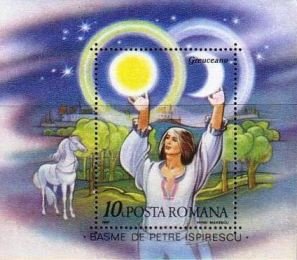Petre Ispirescu facts for kids
Quick facts for kids
Petre Ispirescu
|
|
|---|---|
 |
|
| Born | January , 1830 Bucharest, Wallachia |
| Died | November 21, 1887 (aged 57) Bucharest, Kingdom of Romania |
| Resting place | Bellu Cemetery, Bucharest |
| Occupation | Editor, folklorist, printer, and publicist |
| Nationality | Romanian |
| Notable works | Legende sau basmele românilor (1872) Isprăvile și viața lui Mihai Viteazu (1876) |
Petre Ispirescu (born January 1830 – died 21 November 1887) was a famous Romanian editor, folklorist, printer, and publicist. He is best known for collecting and retelling many wonderful Romanian folk tales. He had a special talent for sharing these stories.
Contents
Early Life and Printing Career
Petre Ispirescu was born in Bucharest. His father, Gheorghe Ispirescu, was a barber, and his mother, Elena Ispirescu, was a great storyteller. Petre grew up listening to countless folk tales. His parents, and even his father's customers, shared many stories.
His parents hoped he would become a priest. He studied with a monk and then with a priest. But in 1844, at age fourteen, he left school. He became an apprentice at a printing house. He hoped to learn more by reading the books printed there. He worked very long hours, sometimes 14 hours a day. By 1848, he became a skilled printer.
In 1854, he started working at the Copainie printing house. Later, he faced a challenge there. The printing house published some secret papers without permission. Petre Ispirescu was arrested and spent a month in jail. He also lost his job.
A New Start in Printing
By the end of 1858, Petre Ispirescu got a new opportunity. Vasile Boerescu, a supporter of uniting the Romanian lands, offered him a job. Boerescu would later become a Foreign Minister. Petre became the manager of a modern printing house. This place had the first mechanical printing press in Bucharest. It also published a newspaper called Naționalul.
This new job helped him meet important people. He met politicians and writers like Ion Ionescu de la Brad and Ion Ghica. In 1863, Vasile Boerescu sold the printing house. Petre Ispirescu then managed the printing house for the Liberal Party's newspaper, Romanul. This newspaper was shut down in 1864.
After that, Ispirescu and two friends started their own company. They called it the United Workers Typography. A year later, Ispirescu wrote a pamphlet called Romanian Typographer. In 1866, the first ruler of the United Principalities of Moldavia and Wallachia, Alexandru Ioan Cuza, stepped down. Ispirescu wrote about this event with sadness. Later, he became the sole owner of his printing house. In 1878, he renamed it the Romanian Academy Publishing House.
In 1866, Petre Ispirescu also became the head of the State Printing House. This was at the invitation of Interior Minister Ion Ghica. He worked there for two years before leaving.
Later Life and Legacy
Petre Ispirescu did not travel much. In 1880, he took his first trip outside Bucharest. It was a short visit to a town called Roșiorii de Vede. In 1883, he had a stroke. He had a second stroke at his desk and passed away on November 21, 1887. He is buried in Bellu Cemetery in Bucharest. Many other famous Romanians are also buried there.
Collecting Romanian Folk Tales
Petre Ispirescu started publishing Romanian folk stories in 1862. He was encouraged by Nicolae Filimon. His first collection had six folk tales. They appeared in a newspaper called Țăranul Român. Later, they were published as a small book. These tales were then added to his famous collection, Romanian Fairy Tales.
He continued his publishing work in 1872. He released Romanian Folk Tales. Riddles and Proverbs. This book had a special introduction by Bogdan Petriceicu Hasdeu. In 1874, he published Folk Anecdotes and Folk Tales. Then, in 1876, came The Life and Feats of Mihai Viteazu. People praised him for his deep knowledge of Romanian folk works.
In 1879, he published Tales of the Wise Old Man. This book retold old myths and parts of Greek mythology in a simple way for children. Alexandru Odobescu wrote the introduction for this book.
His most important work, Romanian Fairy Tales, was published in 1882. It had an introduction written by Vasile Alecsandri.
Works
Ispirescu is especially known for his collections of Romanian folk tales. Here are some of his important works:
- Colecție de șase basme (1862, "A Collection of Six Folk Tales")
- Legende sau basmele românilor. Ghicitori și Proverburi (1872, "Romanian Legends and Folk Tales. Riddles and Proverbs")
- Snoave și Povești populare (1874, "Folk Anecdotes and Folk Tales")
- Isprăvile și viața lui Mihai Viteazu (1876, "The Life and Feats of Mihai Viteazu")
- Poveștile unchiașului sfătos (1879, "Tales of the Wise Old Man")
- Pilde și ghicitori (1880, "Parables and Riddles")
- Legendele sau basmele Românilor (1882, "Romanian Fairy Tales")
- Basme, snoave și glume (1883, "Tales, Anecdotes, and Jests")
- Jucării şi jocuri de copil (1885, "Children's Toys and Games")
- Povești morale. Despre pomul Crăciunului (1886, "Moral Stories. About the Christmas Tree")


